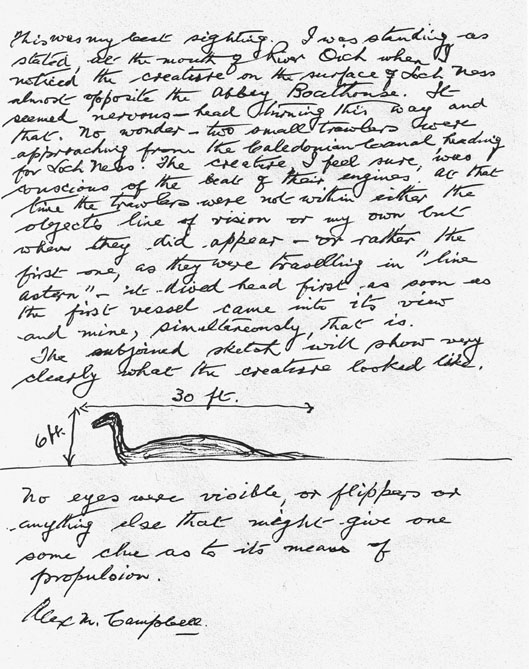
Alex Campbell, water bailiff at Fort Augustus, was a central figure in the story of the Loch Ness monster from 1933 until the 1980's. He was sought out by authors and film-makers, eager for the views of a local person with considerable experience of both the loch and its inhabitants. This page will concentrate on his first and best sighting.
I will start by reprinting his report and sketch, in his own handwriting, made around 1970.

In 1960, Tim Dinsdale visited Loch Ness on his first expedition. His interest was sparked by an article in "Everybody's Magazine" in March 1959 in which the same event was described as follows:
"The early morning mist was clearing fast as I came out of my cottage on the banks of Loch Ness. It was a June morning in 1934. Then, as the mist shredded away under the warm sunlight, I witnessed the most incredible sight I have seen in my forty years as a water bailiff on Scotland's biggest loch. Something rose from the water like a monster of pre-historic times, measuring a full 30 feet from tip to tail. It had a long sinuous neck and a flat reptilian head. Its skin was greyish black, tough looking, and just behind, where the neck joined the body, was a giant hump like that on a camel, though many times bigger. I pinched myself hard, but it was no dream, the Loch Ness Monster out there in the water was real and tangible. For several minutes it lay there contentedly, basking in the early sunlight. The sound of a couple of herring drifters approaching from the lower basin of the Caledonian canal broke the spell, and as the drifter came nearer it lowered its long neck and dived under the dark surface of the loch, disappearing in a turmoil of water and sending up a miniature tidal wave. I have seen one of these strange denizens of the Loch (for there are certainly more than one) several times since. But never quite so clearly..."
The earliest version,below, is logically the most accurate, written down in a letter to his employers, the Ness District Fishery Board, only a few weeks after the event. It is from Rupert Gould's book "The Loch Ness monster and Others", published in June 1934, and covering events as late as May 1934.
(Letter dated 28th October 1933)
One day early last month (Sept 7th 1933), at about half past nine in the morning
I was watching this end of the Loch. The light was very uncertain, there being a
fairly thick haze on the water, and along with this the sun was shining directly
in my eye through the mist, making the visibility very bad. I had not been
watching for more than a minute before I noticed a strange object on the surface
about six hundred yards from where I stood. It seemed to be about thirty feet
long, and what I took to be the head was fully five feet above the surface of
the Loch. The creature, if such it was, and at the time I felt certain of it,
seemed to be watching two drifters passing out of the canal and into Loch Ness
and, whether it was due to imagination or not, I could have sworn that it kept
turning its head and also its body very quickly, in much the same way as a
cormorant does on rising to the surface. I saw this for fully a minute, then the
object vanished as if it had sunk out of sight...
Last Friday I was watching the Loch at the same place and about the same time of
day. The weather was almost identical, practically calm and the sun shining
through a hazy kind of mist. In a short time something very like what I have
described came into my line of vision and at roughly the same distance from
where I stood.
But the light was improving all the time and in a matter of seconds I discovered
that what I took to be the Monster was nothing more than a few cormorants, and
what seemed to be the head was a cormorant standing in the water and flapping
its wings as they often do. The other cormorants, which were strung out in a
line behind the leading bird, looked in the poor light and at first glance just
like the body or humps of the Monster, as it has been described by various
witnesses. But the most important thing was, that owing to the uncertain light
the bodies were magnified out of all proportion to their proper size. This
mirage-like effect I have often seen on Loch Ness, although not exactly in the
same form as I have just described. Other epople who know the loch can verify my
statement as to the mirage, but it only occurs under certain conditions and if
the loch is calm. Then it gives every object - from, say, a gull or a bottle to
an empty barrel - a very grotesque appearance provided that such objects are far
enough away from the observer.
Copyright Dick Raynor 2009